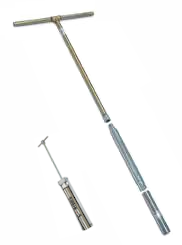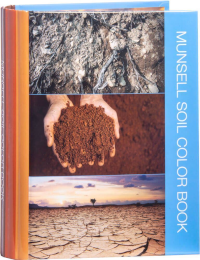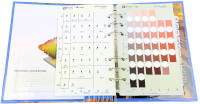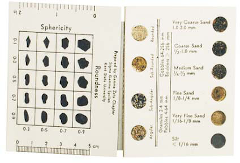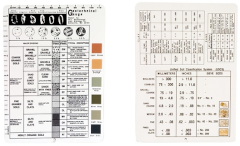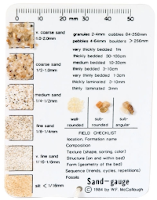Sampling & Classification of Soil
|
Sampling equipment is used to take undisturbed soil sample in soft and fine soils.
16-T0010: Sampling equipment to take undisturbed soil sample 38 mm dia. The apparatus comprises TY-handle, Extension rod, Jarring link, Stainless steel sample tube 38x230 mm length. The sample is obtained by percussion, lifting all the upper assembly which slides inside the jarring link and forces the sample tube into the soil. 16-T0010/6: Stainless steel sample tubes dia. 38x230 mm 16-T0010/7: Single plastic end cap for sample tube model 16-T0010/6 16-T0010/8: Hand extruder for 38 mm dia specimens |
|
Geotechnical classification charts are a guide for classification of size, shape, color, and density characteristics of soils from sands and gravels to silts and clays.
HM-519: Munsell Soil Colour Book The tabbed charts include 10R, 7.5R, 5R, 2.5YR, 5YR, 7.5YR, 10YR, 2.5Y, 5Y, and 10Y-5GY colour ranges. Charts for tropical and semitropical soils, and for Australia and SE Asia are included. A two-page Gley Chart for submerged soils covers weak chromas and neutrals of blue and green hues. A white page is used to describe carbonate, silica, gypsum, soluble salt participates, and more. Openings between chips allow easy visual comparison with soil samples. Illustrations of soil grain structures, charts for estimating proportions of mottles and coarse fragments, colour name diagrams, and instructions are all included. Colour chips are mounted on neutral gray, 7.25x4.25in (184x108mm) water-resistant pages in an 8x6in (203x152mm) loose-leaf binder. |
|
HM-510: Sand Grain Size Chart
Used as a reference tool for describing soil samples and initial site evaluations. It has die-cut cavities filled with precision sieved sand sediment grain particles permanently mounted to the chart. Sand particle sizes are classified according to the Wentworth Scale. This grain size comparator card identifies sand granules in six sand grain sizes and shapes ranging from very coarse sand to silt sand. Particles are also designated by shape as angular, sub-angular, sub-rounded and rounded. Granules, pebbles, cobbles, and boulders are indicated by range of size in millimeters. It also designates scales of sphericity and roundness. The card further indicates well-sorted to poorly-sorted granular materials by diameter and classified as coarse medium, and fine. |
|
HM-512: Geotechnical Gauge
Geotechnical Gauge is a water-resistant 5x7in (127x178mm) plastic card with a lanyard that contains a wealth of information for classification of soils. This two-sided card has six color chips, four patches of sized grains, and four tables for classifying soils by particle size using the Unified Soils Classification System. It also categorizes coarse and fine-grained soils into fifteen descriptive categories from gravels and sands to silts and clays, as well as the sand by type from very loose to very dense, and clays from very soft to hard. In addition, categories are defined by appearance, by handling properties, or by ranges of field and laboratory test results. Edges of the card have separate 0—6in and 0—110mm scales. |
|
HM-513: Sand Gauge
Sand Gauge has nine granule patches which are firmly attached to the handy 3.5x2.5in (89x64mm) water-resistant plastic card to assist in defining roundness and size of particles from 2mm very coarse sand to 1/16mm silt. A checklist is included to assist in making field notes and defining bed thickness. The flipside of the chart has tables of geologic age and carbonate classification information. The gauge has a 0—50mm scale on one edge and an attached lanyard. |

